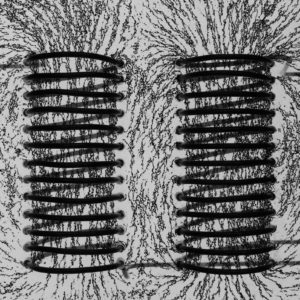This is a picture of two electromagnetic coils next to each other with metallic iron filings sitting on a plane bisecting the coils. The iron filings show the shape of the magnetic field and how it interacts between these two coils.

This is an example of an ideal magnetic coupling. The shape and position of the coils is such that the magnetic field generated by one coil is perfectly balanced and flows through the other coil, inducing an electric current. This is exactly how passive RFID and NFC chips work with a reader. The reader generates a magnetic field and the chip inducts power from that field to operate. If you can achieve a good coupling you will get maximum read range and performance from your chip implant.
Unfortunately this kind of perfect coupling will not typically be possible if you are using our x-series chip implants. That’s because most readers you will encounter have flat spiral antennas that are usually printed as copper traces on flat PCBs. To achieve a good efficient coupling, your chip implant must have a flat spiral antennas as well. This is why we designed our Flex line of chip implants the way we did. They are designed to maximize magnetic coupling in a very small implantable package. However, our x-series chips are cylindrical and the antenna is also shaped around a cylindrical ferrite rod. Luckily, getting a good read is still possible if you know how to position your x-series chip implant properly. This video explains how our xLED Field Test devices can help you locate just the right position for your x-series chip implant.
